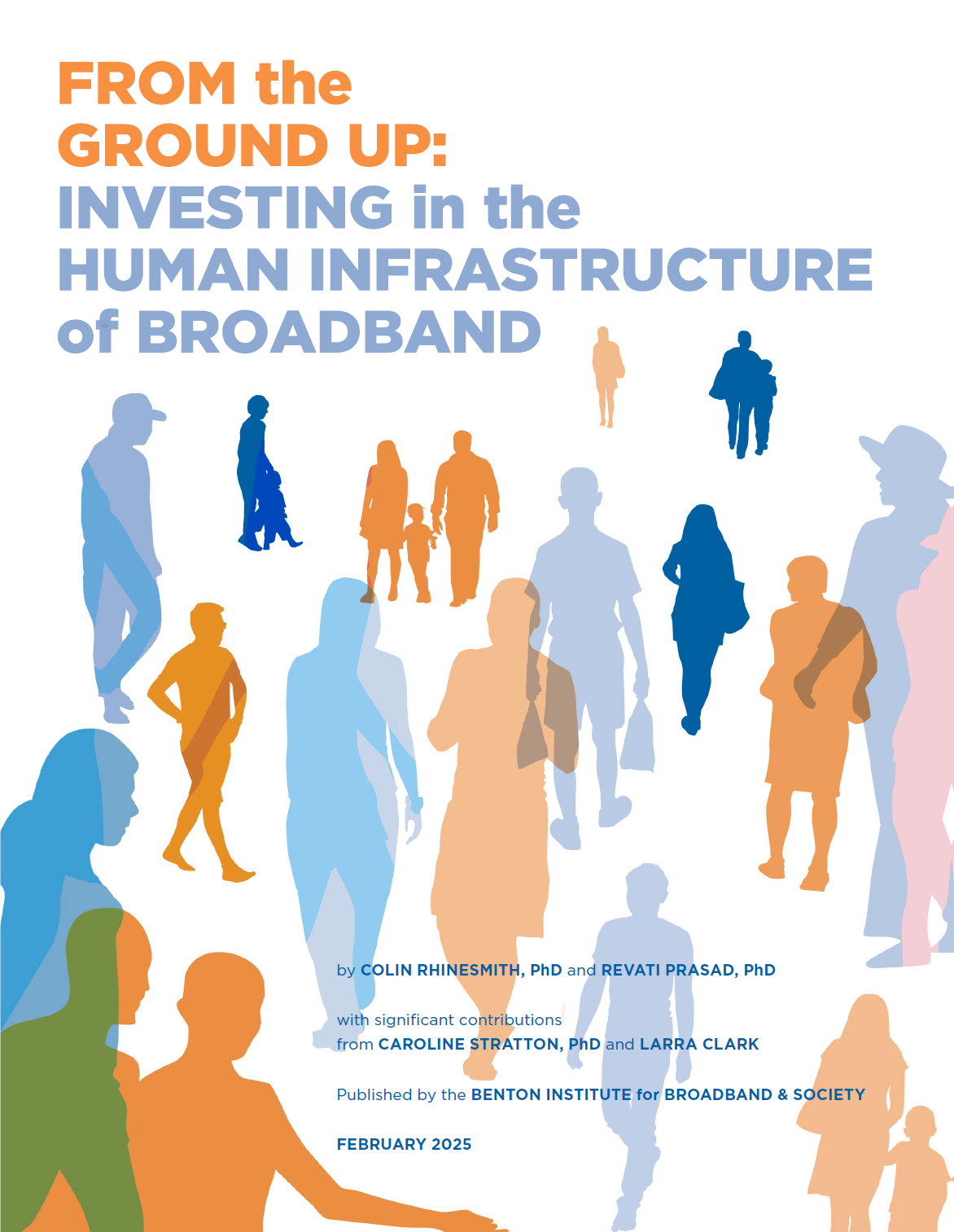From the Ground Up: Investing in the Human Infrastructure of Broadband
A Benton publication written by
Colin Rhinesmith, Ph.D. and Revati Prasad, Ph.D.
With significant contributions from Caroline Stratton, Ph.D. and Larra Clark
When the COVID-19 pandemic forced people to shelter in their homes, individuals and families found themselves unable to access what they needed—broadband service—at the moment when they needed it the most. The human infrastructure of broadband stepped in to help. Schools ran device-lending programs. Local nonprofits helped people sign up for subsidized broadband. Digital equity coalitions emerged to coordinate support. Digital navigators helped people establish email accounts.
Some of these programs had been doing this work for years, but the scale of disruption was such that they expanded the services they provided and prioritized one-to-one direct support. And organizations that had never before considered integrating “digital equity” into their work recognized a need and rolled up their sleeves. Connecting people to the internet is essential because it ensures that all people in the United States can fully participate in the digital economy, our society, and our democracy.
The human infrastructure of broadband” refers to the people and organizations that provide direct support to individuals to access affordable internet and devices and teach people the digital skills necessary to make use of connectivity and fully participate in modern society.
Infrastructure becomes visible only upon breakdown. Otherwise it operates in the background of daily life, largely invisible when it is functioning as intended. But when a water main breaks, a power grid fails, or a cell network has an outage, we are forced to recognize the essential role that infrastructure plays in our lives. Infrastructure failures can also reveal broader systemic inequities because they often disproportionately impact marginalized communities. The human infrastructure of broadband provides a lifeline particularly for vulnerable populations most impacted by social and digital inequality.
How can we support and sustain the human infrastructure of broadband even after current federal investments have ended?
The crisis of the pandemic prompted a significant investment in helping to get people online. The Consolidated Appropriations Act, the CARES Act (Coronavirus Aid, Relief, and Economic Security Act), and the American Rescue Plan Act (ARPA) directed resources for the expansion of broadband infrastructure and digital equity. The Infrastructure Investment and Jobs Act built on these foundations, directing $42.5 billion for infrastructure deployment, $14.2 billion for the Affordable Connectivity Program, and $2.75 billion to digital equity.
Beyond this federal investment, however, funding sources for digital inclusion programs are few and far between. Ironically, the scale of recent public funding can give rise to questions from philanthropies asking why their money is needed and what their role should be. With the National Telecommunications and Information Administration (NTIA) receiving 700 applications from digital equity organizations requesting more than $6.5 billion in funding—a sum five times the amount of funding available in the first round—we know current federal funding is not enough.
Because...
the existing digital divide is largely an artifact of entrenched economic and racial disparities;
new technologies will emerge, causing our devices and skills to become outdated; and
as our lives become ever more digitized,
we will need people and organizations that help connect others to the internet.
The detrimental consequences of not having internet access—on income, on health care, on accessing government services—for our society will be devastating.
This report looks to the future, bringing together insights from previous research and convenings, to craft recommendations for how we can strengthen and sustain the human infrastructure of broadband.
- Section I presents our recommendations for how to sustain this work going forward, informed by our research and the policy and expert convenings we conducted.
- Sections II and III draw on case studies we commissioned and the three expert working groups we convened to present the dynamics of the human infrastructure of broadband at work.
- We close by reiterating the ongoing, universal need for a human infrastructure of broadband and call on our field to build on the current momentum now.
While we outline potential actions at the national level, we are focused on local and state actions, too.
This report is written for policymakers at all levels of government, philanthropic and nonprofit organizations, and other stakeholders. We look forward to working with project partners and others on implementing the recommendations to sustain the human infrastructure of broadband even after current federal investments have ended.
Additional Reading:
- The Human Infrastructure of Broadband: Looking Back, Looking Around, and Looking Ahead
- What We Know About the Human Infrastructure of Broadband
- At the Denver Public Library, People Skills are the Most Important Quality When Choosing Digital Navigators
- The Mercedes Library Exemplifies a Vital Effort to Promote Digital Independence
- How Everyone On Navigates Change to Deliver Digital Equity
- Free Geek, Devices, and Digital Equity
- Mass General Brigham Understands that Digital Equity Supports Health Equity
- Northwest Center Engages Community, Advances Digital Skills
- The Cuyahoga Metropolitan Housing Authority Leans Into Collaboration
- North Carolina Community College System Brings the Classroom to the Learners
- Digital Connect Makes Digital Navigation Approachable
- Black Churches 4 Digital Equity: Community Anchors and Committed Advocates
- Seattle's Equity-Based Approach
- The Kūpuna Collective: A Public Health Coalition Advancing Digital Equity


